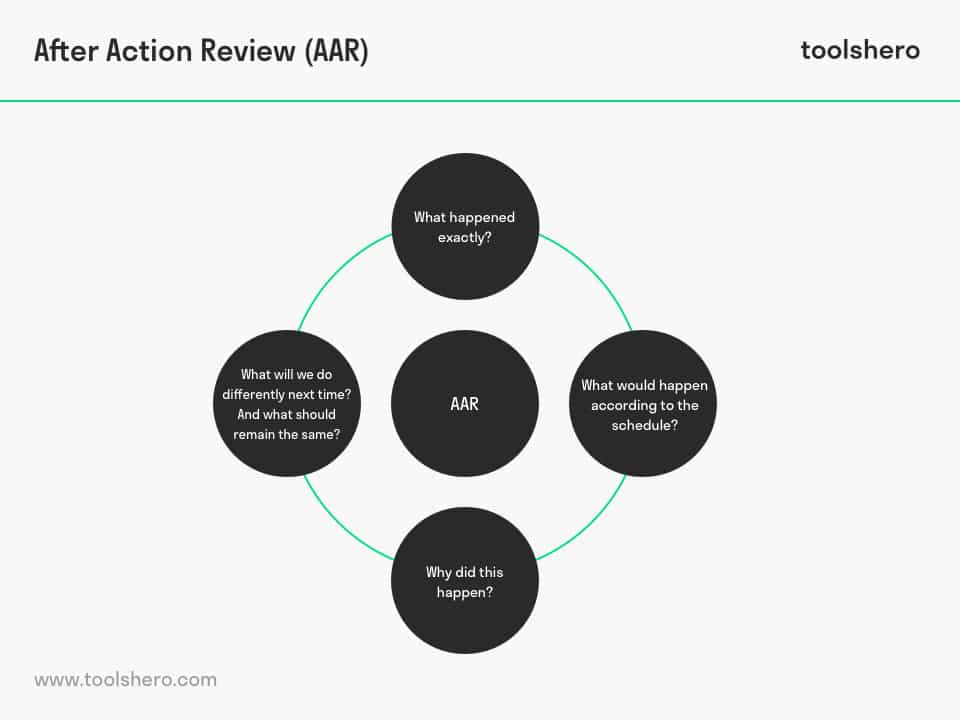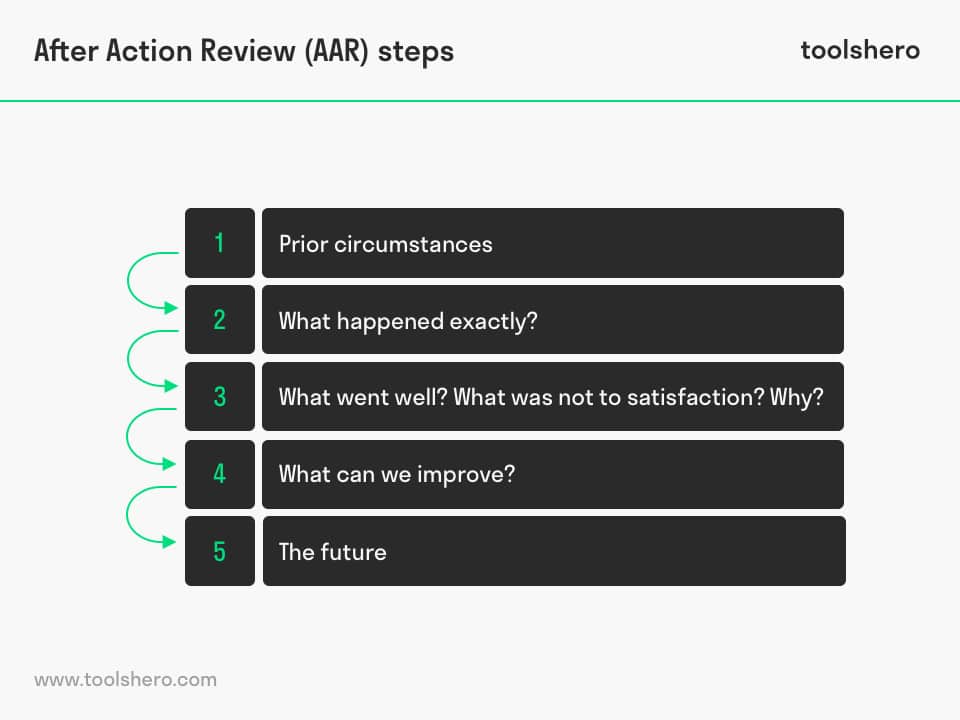After Action Review (AAR)

After Action Review (AAR): this article provides a practical explanation of After Action Review (AAR). The article further contains a general definition of the AAR-method and a practical example. After reading, you’ll understand the basics of this change management tool. This article also contains a downloadable and editable After Action Review template. Enjoy reading!
What is After Action Review (AAR)?
After Action Review (AAR) is a method to assess a project or activity that allows both leaders and employees to discover and learn what happened and why. Organisational learning requires a constant assessment of performance and ensures that continuous improvement takes places. The AAR method is a simple tool to simplify this assessment process and to improve performance.
The AAR is also known as a structured review, or debriefing. In the business world, it is frequently used as a tool for knowledge management, and it is a way to build a responsible and inquisitive business culture.
Formal AAR meetings are usually conducted by a facilitator. The frequency at which reviews take place depends on the situation. Informal AAR meetings are short, can be led by anyone, and are very effective for employees among themselves.
Situations in which effective AAR is used are the introduction of a new product, a review of a busy holiday period, or when upgrading information technology facilities.
Origin and evolution of After Action Review (AAR)
The origin of AARs goes back to the United States army. Around the turn of the century, they started developing a new approach to learn quickly, at any location. They referred to it as the After Action Review (AAR). Initially, the method was developed to support training, but it was soon implemented throughout the organisation, both in official training and beyond.
In practice, this meant that army commanders regularly gathered their troops to ask them a series of questions about their actions. Questions that are common in an AAR session include:
- What would happen according to the schedule?
- What happened exactly?
- Why did this happen?
- What will we do differently next time? And what should remain the same?

Figure 1 – After Action Review (AAR) Process
After Action Review types
There are many different ways to conduct AARs for continuous learning and improvement. The beauty of the tool is its simplicity, creating a lot of potential for adapting the tool and experimenting with it. This way, team leaders can find an approach that works best for their team members in a certain group. The essence of an AAR is to improve team performance by bringing the relevant people together, think about a task, and learn and adapt for the future.
AAR is multifunctional, and is often used in the following ways:
Debriefing
A debriefing can be both formal and informal, and usually consists of a summary of an event or situation. A debriefing is conducted with affected or involved parties. A debriefing is especially suited for smaller tasks, or a shift of duties.
Interviews
In interviews, the structure of After Action Report remains the same. It is about learning from the situation. The difference compared to a debriefing or other group reviews is that participants are interviewed in a one-on-one session. In this form of AAR, participants may feel more comfortable sharing their opinions and ideas more openly than in a group format.
After Action Review step-by-step plan
To learn from After Action Reviews, it is important that those involved learn from the experience themselves. This is why the facilitator must create an open and honest discussion environment. In addition, everyone involved in the issue must be involved in the review.

Figure 2 – After Action Review Process steps
Step 1: Prior circumstances
In step one, it is about identifying the situation prior to the event, task, or project and the intended results of the process. This is important to determine a measuring point. Components such as procedures, cooperation mechanisms, and resources must also be included.
Step 2: What happened exactly?
In step two, one must determine what happened exactly. This can be done efficiently by recording different milestones or events along a timeline. The timeline ensures that a common overview of objectives is created. The timeline can later also be used when looking back at the task.
Step 3: What went well? What was not to satisfaction? Why?
In step three, one must discuss what went well and what went poorly during the project. It is also important that the cause is determined. Discuss challenges, responses to problems, and factors leading to problems.
Step 4: What can we improve?
In step four, it becomes clear what went wrong, and what needs to be done to overcome the identified challenges in the future. Each activity must be clear, concrete, realistic, and fit into the timeline.
Step 5: The future
The activities that need to be conducted in order to be more effective or efficient in the future are determined in step four, and are translated into actionable recommendations in the format of a clear vision about the future in this final step. Activities that require few resources often receive priority (quick win), and activities that require more resources are scheduled as quickly as possible.
Basic rules of After Action Review (AAR)
- Active participation
- Be open to new ideas
- Don’t blame others
- Be creative in your proposals and solutions
- Consensus must be pursued where possible
- There is no ‘good or bad’ input
- Everyone’s input has the same value
- No issues from the review are shared without permission
Summary After Action Review (AAR)
The AAR is a method originating from the American army that is frequently used in business and elsewhere. Because the tool is simple—only 5 questions need to be answered—it can be applied in all situations that teach one how to act the next time.
AARs occur in both formal and informal situations. In formal situations it is mainly about debriefing and interviews, but employees themselves also learn a lot in the workplace by discussing their experiences and assessing performance with After Action Review (AAR).
To form a realistic picture of the situation and future, it is important that a baseline is established prior to measurement. What was the situation like, what were the influences, which procedures were used, and which cooperation mechanisms were in place? Subsequently one must determine what exactly happened, what went well and what went wrong, and what needs to happen to achieve better results in the future.
After Action Review template
Use this After Action Review template to assess a project or activity. Available as an editable template.
Download the After Action Review template
This template is exclusively for our paying Toolshero members. Click here to see if a membership is something for you!Now It’s Your Turn
What do you think? Are you familiar with the explanation of After Action Review? What lessons have you learned? Do you have any tips for learning from previous activities or results? Are you planning on using After Action Review in the future? What questions do you believe are essential in the assessment of a task or project? Do you have any tips or additional comments?
Share your experience and knowledge in the comments box below.
More information
- Altounyan, R. E. C. (1980). Review of clinical activity and mode of action of sodium cromoglycate. Clinical & Experimental Allergy, 10, 481-489.
- Baird, L., Holland, P., & Deacon, S. (1999). Learning from action: Imbedding more learning into the performance fast enough to make a difference. Organizational Dynamics, 27(4), 19-32.
- Morrison, J. E., & Meliza, L. L. (1999). Foundations of the after action review process (No. IDA/HQ-D2332). INSTITUTE FOR DEFENSE ANALYSES ALEXANDRIA VA.
- Willems, R. M., & Hagoort, P. (2007). Neural evidence for the interplay between language, gesture, and action: A review. Brain and language, 101(3), 278-289.
How to cite this article:
Janse, B. (2019). After Action Review (AAR). Retrieved [insert date] from Toolshero: https://www.toolshero.com/change-management/after-action-review-aar-process/
Published on: 03/14/2018 | Last update: 11/10/2022
Add a link to this page on your website:
<a href=”https://www.toolshero.com/change-management/after-action-review-aar-process/”>Toolshero: After Action Review (AAR)</a>







One response to “After Action Review (AAR)”
I think that the AAR is similar to the Gibbs’ Reflective Cycle (Description, Feelings, Evaluation, Analysis, Conclusion and Action Plan) but the questions are what makes it easier to grasp and apply. Indeed, as part of my mentoring practice, I use specific questions to direct the reflection on the work done between mentoring sessions as a tool based on the Gibbs’ Reflective Cycle which renders it very similar to AAR.